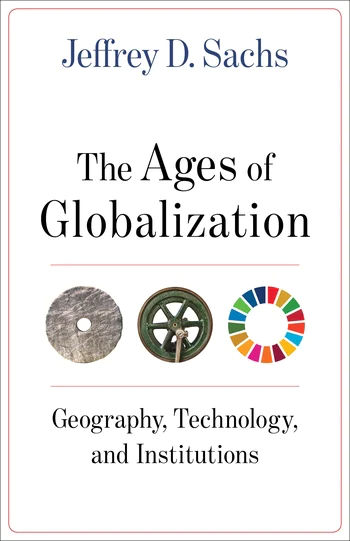By Tim W. Shenk

Jeffrey D. Sachs’s latest book, The Ages of Globalization (Columbia University Press, 2020) sets out to draw lessons from seven eras of human history, from the Paleolithic to the digital era.
Sachs has styled himself as a progressive in debates on global poverty, the environment and foreign and domestic policy. He has been an adviser to governments, foundations and the United Nations. He is often presented as a “savior” of national economies and a leading crusader against global poverty. This new book attempts to broaden that scope even further to present a telling of the forward march of 70,000 years of human history as a framework for the need for global cooperation to solve the world’s most pressing problems.
In order to evaluate this text, we must first go beyond the level of appearances to discuss Sachs himself, including the projects that brought him to global prominence and his current affiliations.
Sachs gained notoriety as an anticommunism expert around the end of the Cold War. The New York Times called him “probably the most important economist in the world” in the early 1990s when he traveled to Moscow to apply the “shock therapy” of free-market economics to Russian society. These policies of mass privatization Sachs oversaw led to crushing spikes in unemployment and upwards of “10 million missing men because of system change,” according to a study published in 2009 in the medical journal The Lancet. The study noted, “the Russian population lost nearly five years of life expectancy between 1991 and 1994” and also suffered rising HIV rates, higher alcoholism and drug addiction rates, as well as the effects of the acute stress related to the transition to a capitalist economy.
Sachs also was brought into Bolivia and Poland to draft similar pro-capitalist economic reforms. He has since been a special adviser to the United Nations and has advised global anti-poverty programs. His primary institutional home is as a professor at Columbia University in New York City, and he is a leading voice in the preeminent ruling-class cadre organization, the Council on Foreign Relations.
This professional trajectory shows us that Sachs has been an important organic intellectual for the ruling class for 40 years. With this understanding, we must evaluate him as not just an individual sharing his personal views, but rather see him as a representative of a ruling minority of society that requires a particular framing of past and present to maintain its power. That is, we have to be able evaluate The Ages of Globalization not primarily based on its face value, but rather work backwards based on what we know about the interests and goals of those who amplify Sachs’s voice.
The ruling capitalist class is a miniscule minority of society that owns the majority of the world’s wealth and the means to accumulate more wealth at the expense of the rest of us. They own the land, the factories, the banks and the mass media. Their representatives and hired intellectuals like Sachs shape national and international policy, populate and advise national governments and set the parameters of debate on every issue. In order for such a small minority to control the mass of the population, a powerful ideological apparatus is required. Noam Chomsky has called this “manufacturing consent” of the governed. Sachs’s book must be read as one such ideological weapon in the arsenal of the superrich.
For the sake of brevity, this review will not fully explore all of Sachs’s arguments. It will be enough here to encourage a critical reading of The Ages of Globalization based on a response to the author’s two basic premises. These are: that “humanity has always been globalized” (p.23), and that humanity must seek global cooperation to tackle the world’s pressing problems (p.21).
First, leading scholars define globalization as a much more recent phenomenon, dating to the latter half of the 20th century. (See sociologists of globalization Philip McMichael, William I. Robinson and Leslie Sklair.) It’s true that humans have always been on the move and have always traded ideas and things. But that’s not globalization. Globalization refers to the rise of a global production system developed by transnational corporations that came about under the capitalist mode of production.
Global production became possible with the cheapening of transportation and communications technologies driven by the computer chip. Around the same time, it became necessary for capital to break down economic barriers related to national borders to maintain or increase profit margins in an era of tight capitalist competition. The specific goal of globalization, then, is to secure the profits of an increasingly globalized capitalist class. Saying that “humanity has always been globalized” obscures the historic period in which this phenomenon has arisen, and for what reason. Sachs removes all serious analysis of class, power and wealth from his telling of history.
Sachs’s second major argument is compelling on the surface but is, I believe, deliberately misleading and ultimately insidious. Sachs argues that all of humanity must come together as one to battle society’s most urgent concerns, “including the control of human-induced climate change; the conservation of biodiversity; the control and reversal of the massive pollution of the air, soils, and oceans; the proper uses and governance of the internet; the nonproliferation of nuclear weapons; the avoidance of mass forced migrations; and the ever-present challenge of avoiding or ending violent conflicts” (p.21). These problems are certainly of concern to all of us. Our lives, the lives of our grandchildren and the survival of many other species on planet Earth depend on solving them.
Yet this global call to arms – or rather cooperation – is framed in such a way that it too obscures the relationship of the capitalist class to the rest of us. It’s not all of humanity who is to blame for the climate emergency. The 2017 Carbon Majors Report detailed how just 100 corporations are responsible for 71 percent of greenhouse gas emissions in the world. The climate emergency is not about us littering less, recycling more or taking shorter showers. It’s about a system of governance that condones and facilitates the profits of a few over the survival of the planet.
All of the most pressing global problems on Sachs’s list are problems because of the relationship of capital to the rest of humanity and the planet. Forced migration only becomes an issue of its current proportion when people are dispossessed of their means to live where they are, which comes about because of capital’s continued expansion and privatization. Violent conflict has only become more incessant under capital’s drive to control sources of wealth. See the 2003 Iraq War as a prime example. Capital has a voracious, insatiable need to grow, to accumulate more and more, to outcompete other capitals – and it cannot and will not “cooperate” except when it’s necessary for a public relations photo op.
In short, Sachs’s list of global problems is missing the biggest problem of all: capitalism and those who defend it. The interlocking web of institutions that protect the right to privately own ludicrous amounts of money and property over our right to live is what is ultimately threatening any sort of sustainable future. That Sachs would obscure this fact is revealing of his position and motivation. Denying the existence of social classes with oppositional interests is in itself an act of class warfare.
The Ages of Globalization should be read, studied and discussed, but not through the lens of its billing as a progressive treatise. It should be treated as a text penned and promoted by the ruling class, meant to manipulate and derail the groundswell for fundamental change we so desperately need.

Thanks for this analysis Tim.
This is very helpful. It has reminded me that there are those few who are provided wonderful public acclaim yet, produce so very little for the commoners. Thank you for this introduction to his book. I will read with what I call a “hermeneutic of suspicion.”
Brilliant critique.
[…] “The Ages of Globalization should be read, studied and discussed, but not through the lens of its billing as a progressive treatise. It should be treated as a text penned and promoted by the ruling class, meant to manipulate and derail the groundswell for fundamental change we so desperately need.” Link to Review […]